Case• 21. Trauma to an immature incisor
SUMMARY
An 8-year-old girl has fractured her upper right permanent central incisor tooth.
History
Complaint
The child is brought in as an emergency by her mother, complaining of a broken front tooth.
History of complaint
Two hours prior to presentation the child had slipped at school, hitting her mouth. One front tooth appears to be broken.
Medical history
The child has mild asthma, but is otherwise healthy.
Dental history
The child has attended the dentist irregularly, has no caries and no experience of operative dentistry. Her mother states that the broken tooth had not appeared normal and may have been decayed.
▪ What additional questions would you ask and why?
Did the patient lose consciousness? This would indicate a relatively severe blow to the head and might indicate significant intracranial trauma. If the patient lost consciousness, even for a short period, they should be referred to hospital where they would almost certainly be admitted for 24 hours of observation. In this case the patient did not lose consciouness.
Was a piece of the tooth broken off and was it found? Missing fragments of teeth may have been inhaled, swallowed, embedded in the lip or lost. If a fragment has been found it must be matched to the fracture to determine whether other pieces remain missing and the patient investigated to locate and remove the pieces. In this case no fragment was found.
Has the patient suffered trauma previously? Previous trauma to this tooth could have resulted in arrested root development, disturbed crown formation or pathological mobility prior to this incident, depending on the age and stage of dental development at the time. Such changes could affect treatment and might explain the parent’s observation that the tooth was not normal. In this case no previous trauma could be recalled by the parent.
Was the damaged tooth fully erupted before the accident? In early mixed dentition, incisors on opposite sides of the mouth may be at different stages of eruption. At this age it would be expected that eruption would be complete but there is wide variation in eruption date and rate. It would be possible to misinterpret incomplete eruption as an intrusion injury if the original degree of eruption were not known. In this case, the child’s mother reported that both front teeth were fully erupted.
What object or surface did the child hit with her mouth? Injury on surfaces such as playgrounds, roads and pavements carries the risk of contaminating the wound with dirty particulate material. Sometimes such foreign material even enters intraoral wounds. Thorough debridement would then be required. It would also be necessary to check the child’s immunization status for tetanus prophylaxis and arrange a booster dose if required. In this case, the child hit the edge of a table.
Examination
Extraoral examination
The child is distressed but is readily examined. There is some slight swelling of the upper lip but no external abrasions or lacerations.
Intraoral examination
▪ The appearances of the teeth are shown inFigure 21.1. What do you see?
The gingival tissues labial to the upper right permanent central incisor are erythematous and swollen. The crown of the tooth appears to be missing and less than 1 mm of the tooth is visible above the level of the gingiva. The visible fragment appears to be an intact incisal edge rather than a fractured enamel or root surface. The lateral incisors show mild hypomineralization of the labial enamel in the incisal third of the crown.
If you were able to examine the patient you would find that the palatal gingiva of the upper right central incisor is also red and swollen. The remainder of the dentition is caries-free. There are no lacerations in the mucosa of the inner aspect of the lip.
▪ What additional examination(s) would you perform?
Injury to the adjacent incisors and teeth in the lower labial segment should be investigated. Vitality, mobility, tenderness to percussion and fractures should be noted. A periodontal probe should be gently inserted into the labial gingival sulcus to confirm or exclude the presence of a deep pseudo-pocket which would indicate traumatic displacement.
▪ Having completed the examination, what question should the examining dentist keep in the back of their mind? Explain why.
Stay updated, free dental videos. Join our Telegram channel

VIDEdental - Online dental courses



